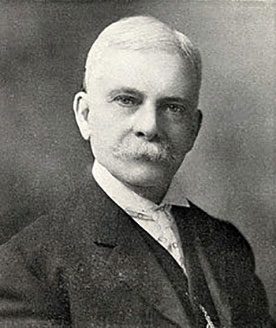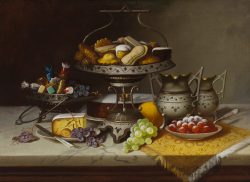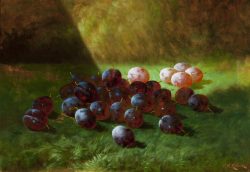C. P. Ream, from an undated photograph, source unknown (www.illinoisart.org).

C. P. Ream 1838–1917
The son of a country lawyer in Lancaster, Ohio, still-life painter Cadurcis Plantagenet Ream probably was self-taught when he began painting professionally in the late 1850s. He was then living in Cleveland, but by 1866 he had moved to New York City, eventually sharing a studio there with his brother Morston, also a still-life painter. Around 1870 Ream began painting images reproduced as mass-market chromolithograph prints published by Louis Prang and Company of Boston. For a series of Prang “dessert pictures,” he painted tabletop displays of fruit and other foods amid luxurious containers and embroidered cloths; he also depicted groupings of single kinds of fruit in natural surroundings. Linked to a tradition of American still-life painting with roots in seventeenth-century Dutch art, these images testify to the material wealth and cosmopolitan aspirations of Americans in the Gilded Age.
During the 1870s, Ream exhibited his work with the Brooklyn Art Association, in Cincinnati, and at the Interstate Industrial Expositions in Chicago, where he moved in 1878 no doubt to take advantage of the city’s burgeoning art market. In the following decade, Ream made several trips abroad. His itinerary included Munich, then a particularly popular destination for midwestern art students. Perhaps inspired by the dramatic brushwork and lighting characteristic of the so-called Munich School, during the 1880s Ream began painting in a somewhat looser manner. His preference for natural settings in his later paintings perhaps reflects the belated influence of the American Pre-Raphaelite movement, whose adherents—many of them still-life painters—followed influential English art critic John Ruskin’s teachings of fidelity to nature.
In Chicago, Ream showed his work in several venues, including the Art Institute of Chicago’s annual exhibitions beginning in 1894, and his paintings were carried by local dealers and sold in a series of auctions. In 1899 a local collector bequeathed one to the Art Institute, reportedly the first work by a Chicago artist to enter the museum’s collection. In 1895 and 1909 the Art Institute held solo exhibitions for Ream, who was then widely hailed as the “king of fruit painters.”i Although he also painted portraits, sentimental genre images, animal studies, and landscapes, Ream’s reputation rested firmly on his talents as a still-life painter. As the artist’s health declined, around 1902, his production largely ceased.
Wendy Greenhouse, PhD
i Giselle D’Unger, “The King of Fruit Painters,” Fine Arts Journal 16 (Oct. 1905): 428-431.

